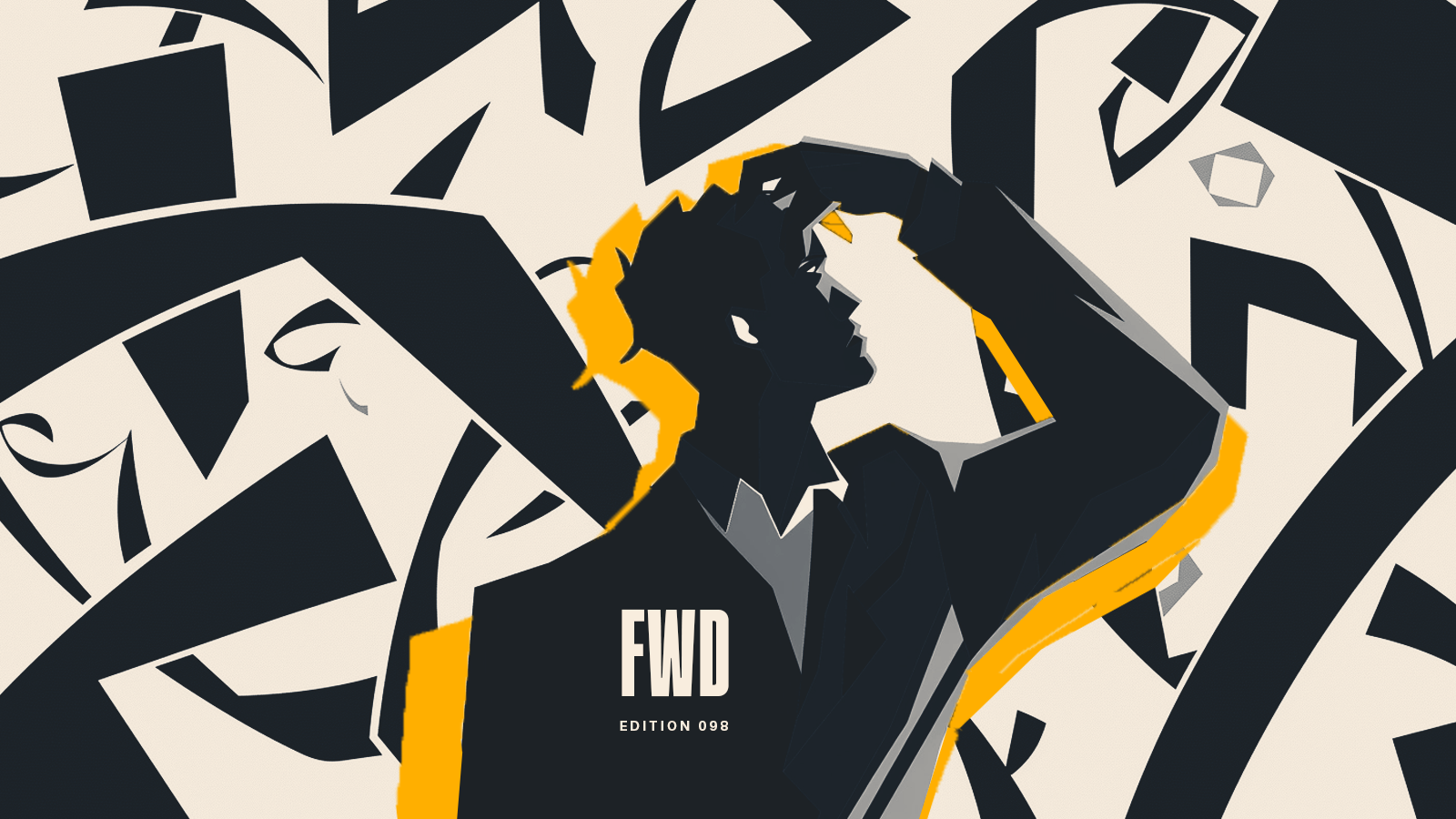Do Not Recommend

FWD Edition 098
Innovation has one job: to improve the human experience by breaking the patterns of the past.
So whether you are testing out a new piece of software for your firm, you're trying the hottest marketing tactic, or the guys at the conference told you to restructure your balance sheet because all the cool kids are doing it, all of those ideas must live up to the standard of Innovation.
If we're honest (and why wouldn't we be?) much of what we've called innovation in the last 10 years fails at both elements of our above definition.
- It doesn't improve the human experience. In fact, in many cases, it makes it worse by commoditizing our lives, turning us into data points, and extracting value from our experiences so they can be packaged and resold to data brokers.
- It doesn't disrupt the patterns of the past. We are nearly 30 years into the digital revolution. Turning ideas into 1s and 0s so that megacorps can profit off them, and then the middle market falls dependent on capital markets to save it... is not a new story. It is now the old story... playing on repeat.
So, if your business, venture, or institution wishes to break the patterns of its peers and, in doing so, achieve different results, it will need to return to legitimate innovation. And that means NOT following the pattern of the digital revolution.
This week's FWD (in a slight twist to our previous format) is all about the hallmark of our digitized lives: Recommendation Systems (broadly called "algorithms") and how you've got to break them, not buy them, to succeed in the market to come.
What is a Recommendation System?
These toxic fumes are so prevalent now that they are hardly recognizeable. They are the air we breathe—From the Instagram algorithm to your Spotify recommendations to the article that shows up at the top of the ESPN app to which bets are suggested to you by FanDuel.
It's also why your Google results make a lot less sense than they used to and why you have to scroll almost half-a-page to find even one non-advertising based solution.
The early internet asked a critical user experience question: How will anyone find what they need in all this junk? Yahoo's answer was their thousands of human curators. Google's answer (which made them trillions) was an automated recommendation system called Page Rank that transformed the web. As Facebook users acquired 1000s of connections and Facebook itself was faced with the need to monetize its user base, your feed turned from chronological to algorithmic. Telling you what to pay attention to based on what the coders at Facebook thought you should, increasingly that which would keep you on the platform and watching ads.
TikTok has weaponized this system to a degree unimaginable just a few years ago.
Not recommended, but curated
Recommendation systems, like any good innovation, initially solved a problem. But now they are the problem. Unfortunately, what once had the benefit of human intellect, emotion, connection, and persuasion (all the things that make lives rich, motivational, and active) is now overrun with the digital hum of the familiar, the mass-produced, the easily recognized, and the encodable.
Whether or not you think of yourself as "on the internet much" or not is immaterial. Nearly everything you do, from buying your spouse a gift to hiring your next great VP, is awash in the Beige Hum of the internet's recommendation systems.
And they are your fast track to mediocrity.
Increasingly, internet users know this. Ad blockers, privacy filters, and digital backdoors are everywhere. Daily usage across the major platforms is falling nearly everywhere, while advertisers complain that even Meta-induced eyeballs can't make sales like they used to.

So we are back to where we started in 2002, an wide world of cool stuff, much of it found through the internet, and no way to slog through it and make good decisions.
It's why the best businesses in the next 10 years won't be aggregators of value or master manipulators of the internet's platforms. Getting big for big's sake and using digital marketing wizardry to make Google your bitch have been tried and found wanting. To Google goes the spoils.
Curators of the good
Instead, ventures like yours will be Curators of the good. Driven by a clear vision of the future, a well-maped ideology of value, and a clear POV on your industry and the pain points of your customers, you will shrink down the world of ideas and options for your clients, and use the wisdom of your team to curate exceptional experiences.
Those who do this, win. They win clients, they win marketshare, they win loyalty, they win referrals.
Without it, you are one more gladiator in the noise arena, batting down the AI bots who exist to digest everything to that familiar Beige Hum of mediocrity.
Four Steps to Curation
- Define your Client A. Client A is not some tacky demo you feed into an ad platform. It's a robust, human, psychographic map of how, why, when, and with whom your very best client makes decisions. We train our clients to be experts on the Decision Engine of one particular profile that could exist across many demographics. The narrower and more colorful the Client A definition, the more likely you are to succeed.
- Believe in a different future. Your industry is broken. In some very obvious ways. You cannot stand out against the field of options for your clients if you don't recognize the pattern of that brokenness and break the pattern. If your vision is "help all Americans live with financial security," you have nothing distinct to offer. You're vision is the same as the FDIC. The future will have winners and losers, in the one that your business is building, who wins?
- Know the field of ideas, hate most of them. To curate for your client, you cannot be a bland neutral politician. "Well all advisors do similar things, we just care more," is a recipe for failure. You've got to build the muscle of strong opinion so that people know what you think and know that you are capable of thinking for them so they don't have to.
- Do what others won't do. Now, build a delivery system of content, connection, and ideas that your Client A will love and that makes their lives easier. Help them choose among the noise, the pantheon of options. Be a tastemaker and a curator of value for what they love. Eliminate any noise. (Sometimes, you are the noise, so stop doing that.)
Do these things, and you can own your growth path. When your Client A, your vision, your curated knowledge, and your client experience are tightly aligned, you can mass-produce the clients you want.
In light of this, here are a few deeper dives and this week's...
Damns to Give
Yes, to unflattening culture.
I built this business to teach businesses how to use the power of internal culture and external "C"ulture to grow organically, authentically, and sustainably. As we discussed above, the Internet is not helping with a lot of that right now. I can't recommend enough Kyle Chayka's new book Filterworld, which heavily influenced this edition.

No, to using big words to say nothing.
Our Higher Ed clients have the hardest time with curation. Inspired by an endless pantheon of ideas, they want to say it all with as many syllables as possible. See the sample below. I've read the below sample of a promotional letter from a Higher Ed leader three times and I'm still unsure what it's trying to say.

Maybe learn the how POV makes influence?
For our friends in marketing and sales, we provide training sessions called "Study Hall" on critical topics that are shifting the growth and strategy world. We believe marketers can and should be strategic leaders and our Study Halls are a tool to help them do that.
We are now waitlisting our next Study Hall: "How Influence is Made" on the intersecting power of POV, content marketing, and strategy. We have very limited spots, so make sure you or your in-house marketers are on the list!


